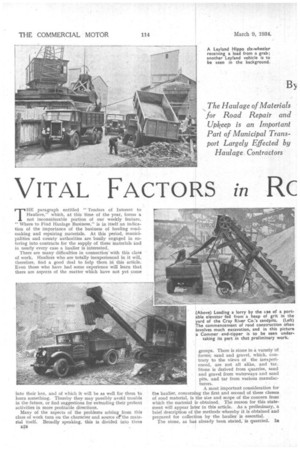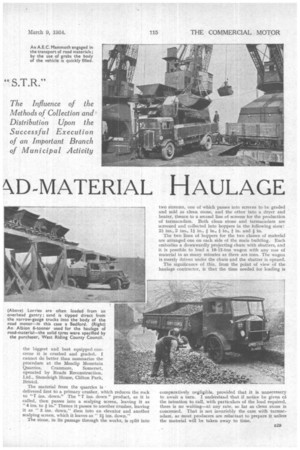VITAL FACTORS
Page 94

Page 95

Page 96

If you've noticed an error in this article please click here to report it so we can fix it.
in Rc
ND-MATERIAL HAULAGE
THE paragraph entitled "Tenders of Interest to Hauliers," which, at this time of the year, forms a not inconsiderable portion of our weekly feature, " Where to Find Haulage Business," is in itself an indication of the importance of the business of hauling roadmaking and repairing materials. At this period, municipalities and county authorities are busily engaged in entering into contracts for the supply of these materials and in nearly every case a haulier is interested.
There are many difficulties in connection withthis class of work. Hauliers who are totally inexperienced in it will, therefore, find a good deal to help them in this article. Even those who have had some experience will learn that there are aspects of the matter which have not yet come into their ken, and of which it will be as well for them to learn something. Thereby they may possibly avoid trouble in the future, or find suggestions for extending their preterit activities in more profitable directions.
Many of the aspects of the problems arising from this class of work turn on the character and source ortbe material itself. Broadly speaking, this is divided into three E28 groups. There is stone in a variety of forms; sand and gravel, which, contrary to the views of the inexperienced, are not all alike, and tar. Stone is derived from quarries, sand and gravel from waterways and sand pits, and tar from various manufacturers.
A most important consideration for Else haulier, concerning the first and second of these classes of road material, is the size and scope of the concern from which the material is obtained. The reason for this statement will appear later in this article. As a preliminary, a brief description of the methods whereby it is obtained and prepared for collection by the haulier is essential.
The stone, as has already been stated, is quarried. In
the biggest and best equipped concerns it is crushed and graded. I cannot do better than summarize the procedure at the Mendip Mountain Quarries, Cranmore, Somerset, operated by Roads Reconstruction, Ltd., Stoneleigh House, Clifton Park, Bristol.
The material from the quarries is delivered first to a primary crusher, which reduces the rock to " 7 ins. down." The "7 ins. down" product, as it is called, then passes into a scalping screen, leaving it as " 4 ins, to in." Thence it passes to another crusher, leaving it as "3 ins, down," then into an elevator and another scalping screen, which it leaves as " 21 ins. down."
The stone, in its passage through the works, is split into
two streams, one of which passes into screens to be graded and sold as clean stone, and the other into a dryer and heater, thence to a second line of screens for the production of tarmacadam. Both clean stone and tarmacadam are screened and collected into hoppers in the following sizes; 23. ins., 2 ins., It in., / in., in., I in. and in.
The two lines of hoppers for the two classes of material are arranged one on each side of the main building. Each embodies a downwardly projecting chute with shutters, and it is possible to load a 10-12-ton wagon with any size of material in as many minutes as there are tons. The wagon is merely driven under the chute and the shutter is opened. The significance of this, from the point of view of the haulage contractor, is that the time needed for loading is comparatively negligible, provided that it is unnecessary to await a turn. I und6rstand that if notice be given of the intention to call, with particulars of the load required., there is no waiting—at any rate, so far as clean stone is concerned. That is not invariably the ease with tarmacadam, as most producers are reluctant to prepare it unless the material will be taken away to time. Sand and gravel are excavated from pits, sometimes from the bed of a river, sometimes from a lake and, even where there is no water to commence with, it is often present after excavatian has proceeded some little time.
The Cray River Sand and Gravel Company's pits exemplify the last-named condition. There, where, some few years ago, was land, is now water. The plant is typical of a modern sand and gravel pit. The material is dredged from the bottom of the lake, conveyed to washers, screens and hoppers or, alternatively, if not to hoppers, to mounds of graded material in the yard belonging to the premises. Here, again, there is little or no delay in. loading. Only 10 minutes are needed either to collect and load irorn the hopper, or from one of the mounds, whence the load is delivered into the vehicle by means of a power-driven elevator. Soft sand, usually employed for building purposes, is excavated by grab from the aendpit and is sometimes loaded direct by the grab into the vehicle.
Sometimes, however, when the result of months, or perhaps years, of excavation has somewhat altered the contour of the site, it may be that excavation is proceeding some distance from a point where it is convenient to Toad vehicles. Then the sand is, in many cases, loaded into small tip wagons on narrow-gauge lines and hauled to the loading bay by small• internal-combustion-engined locomotives. The road vehicles are run underneath the gantry carrying the narrow-gauge lines and
are loaded, sometimes by the simple process of tipping the truck so that the sand falls
directly into the road vehicle. Alternatively, a truck tips into a slanting metal chute which delivers into the road vehicle. From the point of view of depreciation and maintenance of the road vehicle, the latter method is to be preferred, for the effect of dropping a couple of tons of sand from a height of 10-15 ft. into a sprung road vehicle is obvious.
Many contracts for the haulage of road material for municipalities and county councils provide for collection of the material from railway trucks, in which case, of course, most of the loading has to be done by hand. The majority of these contracts provides, too, that the haulier shall pay demurrage if he delays in collecting the material from the railway trucks.. In the case of a railway-owned truck this charge may amount to as much as 3s. per day.
In such circumstances, the time for loading depends largely upon the skill and energy of the driver and his mate. Efficient men can load six tons of stone in 40 mins. and I £30
have known cases where the same weight of sand has been transferted from the railway Struck to the lorry in 20 minutes. The unloading of these materials does not, normally, take long. A tipping wagon or a vehicle with a movable floor is generally used and, even where the load has to be deposited in several heaps, a great deal of time is not lost.
Here, again, experienced men are a help. I have known two men load and unload 321 tons of tarmacadarn in a day. The lead, of course, was a comparatively short one, but it will be appreciated that the performance is equivalent to loading and unloading 6 tons within the hour.
Tar is customarily conveyed.
in drums or barrels. The rate paid is usually about the same as that offered for stone and, the bulk being such that, normally, four tons comprise a load for a a-tonner, the profit, if any, is meagre. Four barrels of tar represent a ton. The conditions usually provide that a couple of barrels must be dropped every 150 yds., or, if they be drums, at the rate of 40 to the mile. Mileage is calculated to the mid-point of the stretch over which a particular toad is to be dumped.
A feature of contracts for municipalities which sometimes proves rather troublesome to hauliers is the rather complicated returns that have to be made. Maybe in a year or two, when they have all become accustomed to filling in the records which are to be called for under the Road and Rail Traffic Act, this will not appear so formidable.
On a typical form which lies before me at the moment, there are no fewer than 16 columns, all of which have to be completed exactly and according to rule, before the account for the work done is passed for payment.
In connection with municipal haulage, the need for charging economic rates cannot be too strongly emphasized, particularly in view of the fact that some authorities impose onerous conditions upon the contractor in carrying out the work. For further information on the subject I refer readers to "Raising Municipal Haulage Rates" (pages 134-135). Most rates for municipal haulage undoubtedly required. to be increased to show a reasonable margin of profit, even before taxation was raised and other extra expenses resulting from recent legislation, were imposed. Now the position is greatly magnified in its severity.












































































































































































